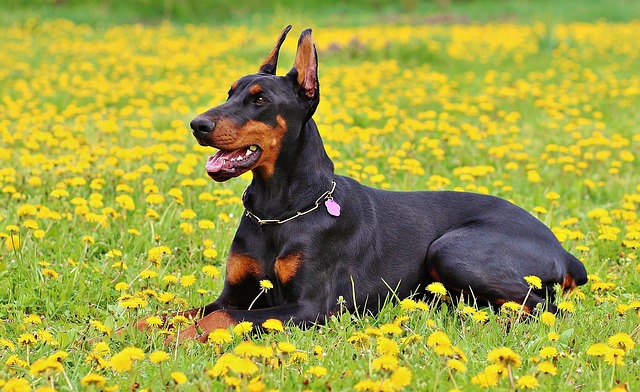Dobermans are a breed synonymous with agility, intelligence, and loyalty. Known for their sleek coat, athletic build, and regal posture, they exude an air of confidence and dignity. Developed in Germany in the late 19th century by a tax collector named Louis Dobermann, these dogs were bred primarily for protection. This origin has instilled in them a unique set of traits tailored for guarding and companionship. While Dobermans are well-regarded for their protective instincts, they also exhibit some quirky and unusual habits that can be both intriguing and endearing. These behaviors often reflect their complex psychological makeup and the depth of their emotional intelligence. In this article, we explore seven of the most unusual habits of Dobermans, providing insights into the behaviors that shape this distinctive breed.

1. “Blanket Fluffing”
Dobermans often engage in what is affectionately known as “blanket fluffing.” This behavior involves them using their paws to rearrange their bedding or any area where they plan to lie down. While this might seem a common trait among dogs, Dobermans do it with a particular intensity and purpose. This habit likely stems from their need for a comfortable and secure resting place, reflecting their methodical and precise nature. Owners will often find their Doberman meticulously pawing at blankets until they are just right, which shows their preference for order and comfort.
2. Extreme Loyalty Display
Dobermans are known for their extreme loyalty to their owners, often forming a strong, protective bond with a single person in the household. This can manifest in an unusual habit of shadowing their favorite person obsessively, following them from room to room, and exhibiting anxiety if separated. This behavior reflects their original breeding purpose as personal protectors. While this loyalty is admirable, it can sometimes lead to overprotectiveness or separation anxiety, which requires careful management through training and socialization.
3. “Grinning”
Some Dobermans have the unusual and sometimes disconcerting habit of “grinning.” This behavior involves pulling back their lips and showing their teeth in a way that resembles a human smile. Although it might appear aggressive to those unfamiliar with the behavior, this “grinning” is actually a sign of excitement or submissiveness in Dobermans. It’s a distinctive way they communicate happiness, often seen when they greet their owners or when they’re particularly pleased.
4. Sensitive Stomachs
Interestingly, Dobermans often have sensitive stomachs, a trait not typically emphasized but quite common in the breed. This sensitivity can lead them to have unusual eating habits, such as eating grass or refusing food that doesn’t meet their preference or dietary needs. Owners need to monitor their Doberman’s diet closely and may need to experiment with different types of food to ensure their dog remains healthy and happy. This unusual trait underscores the need for careful management of their physical well-being.
5. Obsession with Water
Many Dobermans exhibit an obsession with water, whether it’s a penchant for drinking copious amounts or a love for playing in it. This can be unusual for a breed not specifically known for water work. Dobermans may enjoy splashing in a pool, running through sprinklers, or just immersing themselves in water bowls. This behavior is a playful expression of their energetic nature and provides a fun outlet for their high energy levels.
6. Collecting Objects
A quirky habit some Dobermans develop is collecting and hoarding objects they find valuable or comforting. This can include toys, shoes, or even items like rocks and sticks from the yard. They often keep these treasures in a specific spot and may return to them frequently. This behavior highlights their intelligent and sometimes possessive nature, showing a deep connection to their environment and belongings.
7. Sleeping with Eyes Open
Lastly, some Dobermans have the eerie and unusual habit of sleeping with their eyes partially open. Medically referred to as nocturnal lagophthalmos, this trait can be unsettling to observe but is generally harmless. It may be a residual instinct, keeping them partially alert even during rest, reflective of their historical role as guard dogs always ready to protect.
Learn More About the Doberman Dog Breed: Information, Facts & Pictures
In conclusion, Dobermans are not only one of the most effective guard dog breeds but also one of the most complex. Their unusual habits, ranging from the endearing to the perplexing, illustrate a breed rich in character and intelligence. Understanding and appreciating these idiosyncrasies can greatly enhance the relationship between a Doberman and its owner, providing deeper insight into their unique needs and behaviors.
 Toledo, United States.
Toledo, United States.